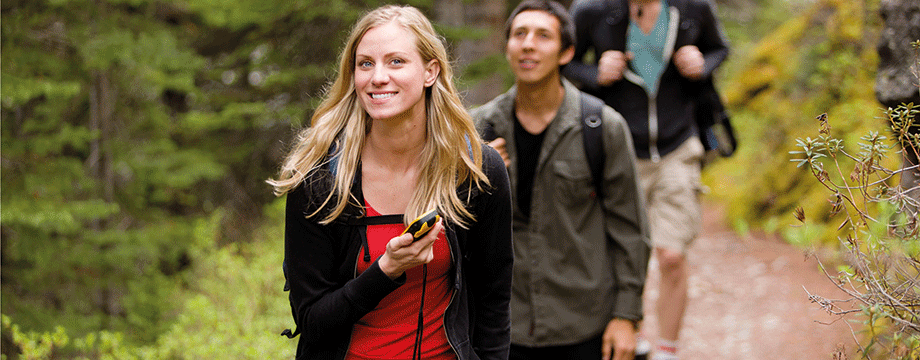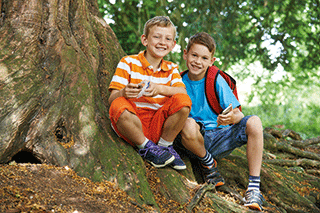A modern day treasure hunt

Liz Parry takes a look at what’s involved in geocaching and how it could boost your health and fitness
Thanks to computers, video games, TVs and mobile phones, children today are spending more and more time indoors in front of a screen instead of enjoying fresh air and outdoor exercise. With childhood obesity on the increase, activities that inspire kids to get outside, become physically active and explore their surroundings are to be encouraged.
Geocaching is a fun, family-friendly outdoor activity that offers a modern take on the traditional treasure hunt. Participants are known as ‘geocachers’ and their aim is to discover the location of hidden ‘geocaches’ or ‘caches’ that are concealed around the world. Very little equipment is needed to take part other than a GPS device or GPS-enabled mobile phone, access to the internet and a sense of adventure.
“A geocacher will go to a location which usually has some special interest or beauty,” explains Ant Read, from the Geocaching Association of Great Britain (GAGB). “At the location, they will hide a small waterproof box containing a few varied bits and pieces (usually of little value), a logbook and a pen or pencil. Using their GPS receiver, the cacher records the co-ordinates of their cache and returns home to log its existence on a website. Another cacher will see the listing about the cache, enter the co-ordinates into their GPS receiver and go in search of it. When they find it, the finder may take something from the cache and leave something in return, and for posterity, enter a log in the logbook. When the finder returns home, he or she should log on the website that they have found the cache and pass on any comments they wish. These logs are important to the cache hider as it is part of their ‘reward’ for hiding the cache.”
Getting started
So how do you get started? You can find details of geocaches in your area on websites like www.geocaching.com. These will provide you with information on the caches as well as their co-ordinates. If you have a Smartphone you can download a geocaching app and follow the instructions. It’s worth bearing in mind that a lot of caches are hidden in the countryside away from public transport routes so it might be beneficial if you have access to your own transport. When you set out to find a cache, make sure you take some items or trinkets with you to use as swaps in the caches you find. The spirit of the game is that if you take something, you should leave something in exchange.
Geocaching originally began in 2000 in Portland, Oregon, by a computer consultant called Dave Ulmer. His initial aim was to test the accuracy of GPS technology by hiding a stash of objects in the woods, noting down the co-ordinates of the site and issuing a challenge to other GPS enthusiasts to find it. The challenge was swiftly taken up, and other enthusiasts followed suit, hiding their own stashes for others to find. Now, 16 years later, there are millions of geocachers across the world, and geocaches have been hidden in over 100 countries. What’s more, people like Catherine Cooper, a mum-of-two from London, are realising that geocaching is a great way of getting the family together to enjoy an outdoor activity.

“The kids are pretty good about going for walks anyway but the ‘treasure hunt’ and technology aspect of it certainly made them keener to keep moving and go further,” says Catherine, who first tried out geocaching whilst on holiday with her family in the French Alps. “I think we all liked having a purpose to the walk rather than it simply being a walk. It’s nice to read other people’s comments in the caches and online – it makes you feel like you’re part of something big. It’s a good way to get the kids more active and it can boost your health and fitness as you’re doing a fun activity rather than something which is a chore.”
Fresh air and exercise
“Anything involving walking in the fresh air is good for you,” adds Claire Annals, a mum of two from Worksop in Nottinghamshire. “I have a sedentary job and my husband works for long hours indoors so we don’t have a very healthy lifestyle. Geocaching enables us to get out and about, get a bit of exercise and spend time with the kids. It also helps us to explore a different side of our own area or areas that we visit. It does take a little planning but we know we are going to have an interesting day.”
“The joy of it is that it takes you to parts of a city or a country that you might not normally go to,” says Marc Lambert, a geocaching enthusiast from London who has travelled the world hiding and finding geocaches. “A few years ago myself and a friend went on a two-day hike across Dartmoor – an 18-mile round trip – to find a geocache and we camped overnight on the way.”
Marc is now preparing to embark on a trip to Kyrgyzstan this summer where he will hide geocaches in areas that they have not been placed before. His 24-day expedition is going to be called Follow in Their Footsteps and the aim is to raise money for a school in Kyrgyzstan as well as increasing the profile of geocaching around the world.
“Have a look at caches in the area before you go,” advises Claire. “You might want to download them in case you don’t have a signal when you get there. If you are going to a National Trust property they often have caches aimed at children. Take the time to post a little comment about the cache – a lot of work goes into hiding them and the owners appreciate a nice comment about how much fun your family had, staring at the bushes for half an hour to try and find a small plastic tub wrapped in camouflage tape! Most importantly, take care not to damage the area you are searching, not to leave litter and don’t shout loud enough to disturb wildlife!”
Further info
For more information on geocaching, visit the Geocaching Association of Great Britain (GAGB) – www.gagb.org.uk or www.geocaching.com where you can find details of the free app.
Read previous Your Outdoor Living articles here...
Read articles from our latest issue here...